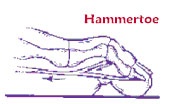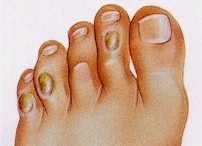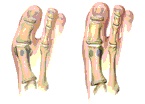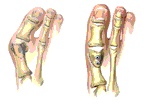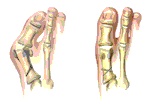Bunions
Hallux Abducto Valgus
A bunion deformity is a structural deformity caused by abnormal biomechanics in which the first metatarsal drifts away from the second metatarsal. This causes the big toe (hallux) to drift towards the second toe. The result is a bump or prominence of the inside aspect of the foot and the big toe hitting up against the second toe.
With a course of conservative treatment consisting of anti-inflammatory medications and orthotics, the pain associated with the bunion may be alleviated and surgery can be delayed. Surgical correction, if indicated, is aimed at realigning the first metatarsal with the second.
Many patients will be able to wear comfortably fitting shoes within six to
eight weeks, but a return to full activity might take up to three to six months.
Hammertoes
Hammertoe deformity is a structural deformity in which abnormal biomechanics cause the toe(s) to contract at one, two or all three of the joints within that toe. When in its early stages,
the deformity is flexible. Normally hammertoes by themselves are not painful,
but with foot wear, the prominent knuckle of the toe rubs the shoe, producing
an area of irritation which eventually forms a corn.
Temporary relief of painful symptoms can be achieved by having one of
our podiatrists debride (trim) the corn often present with this deformity. When the contracture becomes rigid and nonflexible and increased swelling and pain persist, then surgical correction might become necessary to alleviate symptoms.
Corns and Calluses
Corns and calluses are NOT soft tissue problems and there is no "root" to
be removed. No matter how much they are cut down or debrided, they will
return. Painful corns and calluses are the result of abnormal position of
the underlying bone. Often hammertoes become painful because a bursal
sac will develop between the bone and corn or callus. The bursal sac can
be treated with injections and anti-inflammatory medications. If this
relieves the symptoms then surgery can be delayed. If these treatments
fail, then structural correction of the hammertoe is recommended by your physician.
